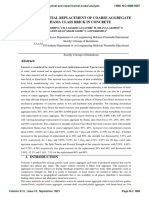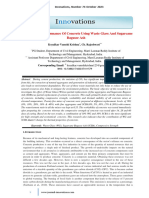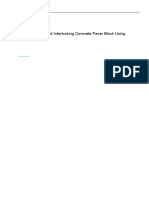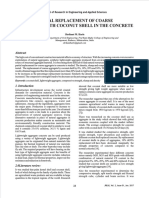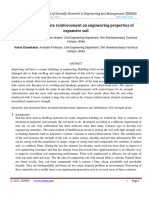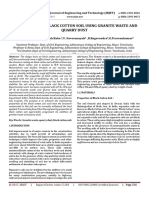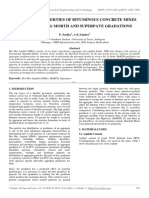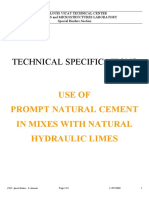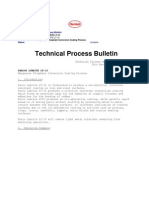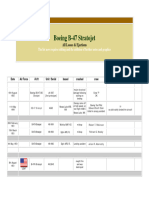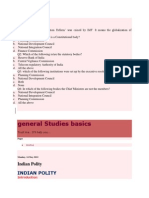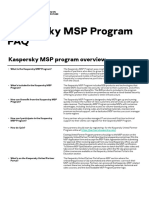IJEDR1802132
IJEDR1802132
Uploaded by
ayat arahmanCopyright:
Available Formats
IJEDR1802132
IJEDR1802132
Uploaded by
ayat arahmanCopyright
Available Formats
Share this document
Did you find this document useful?
Is this content inappropriate?
Copyright:
Available Formats
IJEDR1802132
IJEDR1802132
Uploaded by
ayat arahmanCopyright:
Available Formats
© IJEDR 2018 | Volume 6, Issue 2 | ISSN: 2321-9939
Effect Of Lime And Brick Dust On Compaction
And Swelling Property Of Black Cotton Soil
Nikhil Tiwari1, C.D.Prasad2
1
M.tech Scholar, UCE, Kota (Rajasthan)
2
Associate Professor, civil engineering department UCE, Kota (Rajasthan)
_____________________________________________________________________________________________________
Abstract - The black cotton soil also known as expansive soil due to its property of swelling and shrinking with change
in moisture content, this property makes the black cotton soil counterproductive for the construction of roads, designing
of flexible pavements and embankments. Many researchers found that change in properties is due to reaction with water
that leads to reduction in strength. To improve the behaviour and engineering properties of black cotton soil, it needs to
be stabilized using suitable stabilizers. So in this present investigation lime and brick dust are used at different
proportions to stabilize the black cotton soil. The proportion used in this experiment is 2% lime with 10, 20, 30, and 40%
brick dust in black cotton soil& another proportion used is 4% lime with 10, 20, 30 and 40% brick dust in black cotton
soil. The test conducted are, compaction test, Atterberg’s limit test and differential free swell index test. From the above
test result we observed exceptionally great decrement in swelling and increment in maximum dry density of the soil.
Keywords - Soil stabilization, black cotton soil, brick dust, lime, swelling property
_____________________________________________________________________________________________________
II INTRODUCTION
The black cotton soil is found in greater amount all over the world and is unsuitable for construction purpose. It contain
montmorrilonite mineral which have tendency to expand and shrink due to this property they are named expansive soil. The
engineering properties of fine grained soils depends on water content present in them .Plasticity index is the main parameter of
classification of black cotton soil which depend on the liquid and plastic limit. Black cotton soils become very hard in their dry
state and contain high bearing capacity. The swelling property generally increases with increase in plasticity index. So this
parameter should be reduced to improve the black cotton soil’s property. They are clayey soils and undergo volumetric change
with effect of water content, this volumetric change lead to swelling and shrinking property in the soil, due to this, the structure
built over it go through many problems such as, undulation, uneven surfacing, cracks and settlement. They have less shearing
resistance and are not appropriate for the construction. So to enhance its engineering property many admixtures can be added to
it, in this present investigation lime and brick dust are used. Lime is already known for its binding property it is widely used as
a stabilizer we used brick dust with it to lessen the cost of maintenance and make it economical as brick dust is locally available
waste material, its disposal is a challenge to the environment so this investigation is done to find out its effect on the engineering
property of black cotton soil. Earlier many researchers have worked on it and found that it is suitable for the stabilization of the
black cotton soil.
III MATERIALS USED
1. Black cotton soil
It is also known as expansive soil due to its property of swelling it shows swelling and shrinking with change in water
content. The soil used for the present experimental investigation is bought from Kunhadi region of Kota city of
Rajasthan. The basic property of the soil are given in below table
Table 1 Properties of Black Cotton Soil
Property Value
Water Content 17.5%
Maximum Dry Density 1.59g/Cc
Liquid Limit 43.07%
Plastic Limit 17.89%
Plasticity Index 25.18%
UCS 2.07kg/Cm3
Soaked CBR 2.4
2. BRICK DUST
Brick dust is a waste material produced in tons of amount in brick kilns and tile processing plants. It is red in colour
and is fine in nature. It has great ability to reduce swelling potential of black cotton soil. Brick dust is mixed with lime
to study their combined effect on engineering properties of black cotton soil. The brick dust used in this investigation
is brought from brick kiln near Taleda region of Kota city.
Table 2 Engineering Properties of Brick Dust
Engineering Property Value
Grain Size Analysis
1.Gravel Size 0
IJEDR1802132 International Journal of Engineering Development and Research (www.ijedr.org) 718
© IJEDR 2018 | Volume 6, Issue 2 | ISSN: 2321-9939
2.Sand Size 86
3. Fines 14
Plasticity Characteristics NP
IS Classification SM
MDD 1.36g/Cc
OMC 33%
Soaked CBR 21.17
3. QUICK LIME
It gives binding property to the soil and increases its bearing capacity as it reacts with clay and forms cementing agents such as
calcium silicate and alumina Quick lime is the common name of calcium oxide it is a chemical compound often used as a
stabilizing agent. It has many qualities such as bond strength, cohesion, adhesion, comprehensive strength etc so it is also used
as a building material. Using lime as a stabilizer it improves engineering properties of soil such as strength, resistance to
deformation, decrease in liquid and plastic limit hence plasticity index is also reduced, it increases maximum dry density and
reduces moisture content but after attaining its peak value it might led to decrease in MDD. The stabilization is a process to
increase and improve quality and strength of the weak soil such as black cotton soil for such stabilization stabilizer is needed
such as lime, the lime is obtained from local market for the intended purpose.
IV TESTS PERFORMED AND RESULTS
1. Sieve Analysis
The wet sieve analysis of soil particles is done by using 75 microns sieve.from the result obtained the soil can be
considered as fine grained soil as more than 50% of particles passed through sieve. Based on these results
classification is done as per IS 1498(1970). The following table shows the result of wet sieve analysis.
Table 3 Sieve Analysis of BCS
PARTICAL Wight %Wight Cumulative Cumulative
IS SIEVE
SIZE (mm) Retained Retained % Retained % finer
4.75 4.75 0 0 0 100
2 2 8.9 0.89 0.89 99.11
1 1 9.9 0.99 1.88 98.12
0.6 0.6 12.3 1.23 3.11 96.89
0.425 0.425 15.3 1.53 4.64 95.36
0.3 0.3 15.8 1.58 6.22 93.78
0.212 0.212 16.1 1.61 7.83 92.17
0.15 0.15 14.2 1.42 9.25 90.75
0.075 0.075 22.6 2.26 11.51 88.49
Pan 884.9 88.49 100.00 0.00
Total 1000 100
Partical Size Distribution
100
99
98
97
Percentage finer (%)
96
95
94
93
92
91
90
89
88
87
86
85
0.01 0.1 1 10
Particles size (mm)
Figure 1 Particle Size Distribution Curve of BCS
IJEDR1802132 International Journal of Engineering Development and Research (www.ijedr.org) 719
© IJEDR 2018 | Volume 6, Issue 2 | ISSN: 2321-9939
2. STANDARD PROCTOR TEST
In standard proctor test soil sample is taken in a mould having 1000ml capacity and having internal diameter of 10cm.
The soil is compacted in three layers with 25 blows per layer by a rammer of 2.6Kg falling from a height of 310mm.
This process is repeated for different water content and a graph is plotted between dry density and water content to
determine maximum dry density and optimum moisture content.
The results for 2% lime and brick dust is shown below
TABLE 4 STANDARD PROCTOR RESULT FOR BLACK COTTON SOIL WITH 2%LIME AND BRICK DUST
Percentages of lime and brick Maximum dry density Optimum moisture content
dust with black cotton soil. (g/cm3)
Black cotton soil 1.59 17.5
BCS+2%lime+10%BD 1.69 15.4
BCS+2%lime+20%BD 1.77 14.5
BCS+2%lime+30%BD 1.82 14.1
BCS+2%lime+40%BD 1.84 13.3
It can be seen that with increasing percentages of brick dust at 2% lime in black cotton soil the maximum dry density of the soil
increases and the optimum moisture content gets decreased. Due to presence of lime and brick dust the weight of the soil
specimen increases with increase in stabilization content. The maximum dry density increases up to 1.84 g/cc from 1.59 g/cc.
The MDD value for 2% lime with 10, 20, 30 and 40% is 1.69, 1.72, 1.82 and 1.84 g/cc respectively. Similarly there is decrease
in optimum moisture content with increasing percentage of brick dust the OMC of black cotton soil decreases to 13.3 from 17.5
the decrement in OMC for 2% lime with 10, 20, 30 and 40% brick dust is 15.4, 14.5, 14.1, and 13.3 respectively
The result for 4% lime with different percentages of brick dust in black cotton soil are as follows
TABLE 5 STANDARD PROCTOR RESULT FOR VIRGIN SOIL MIXED WITH 4% LIME AND BRICK DUST
Percentages Of Lime And Brick Dust With Black Cotton Maximum Dry Density Optimum Moisture Content
Soil. (g/cm3)
Black cotton soil 1.59 17.5
BCS+4%lime+10%BD 1.74 14.9
BCS+4%lime+20%BD 1.82 13.9
BCS+4%lime+30%BD 1.88 13.1
BCS+4%lime+40%BD 1.95 12.5
The above table shows the result of compaction test at 4% lime and different percentage of brick dust it can be conclude from
above table that with increase in brick dust the MDD increases and OMC decreases. The decrease in OMC is up to 12.5 from
17.5.The decrease in OMC at 4% lime and 10, 20, 30 and 40% BD is 14.9, 13.9, 13.1, and 12.5 respectively. The increase in
MDD value reaches up to 1.95 g/cc. The increase in MDD and decrease in OMC is due to change in size and behaviour of
particles as clay size particles changes to silt due to presence of lime. Brick dust being a granular material increases the weight
of the soil hence the MDD of specimen increases.
3 ATTERBERG’S LIMIT
The liquid limit and plastic limit test results are as follows
TABLE 4.4 ATTERBERG’S LIMITS FOR BCS MIXED WITH 2% LIME AND BRICK DUST
Percentages of lime and Liquid limit Plastic limit Plasticity index
brick dust with black
cotton soil.
Black cotton soil 43.072 17.894 25.178
BCS+2%lime+10%BD 39.214 16.250 22.964
BCS+2%lime+20%BD 34.622 15.436 19.18
BCS+2%lime+30%BD 31.567 13.382 18.18
BCS+2%lime+40%BD 28.857 12.5 16.357
From the above figure and table it can be concluded that with increase in percentage of brick dust in 2% lime mixed with black
cotton soil the liquid limit and plastic limit of the soil decreases and so does the plasticity index. This decrement in plasticity
index, changes soil from CI to CL.
The decrement in liquid limit is up to 28.85 from 43.07%, the decrement in plastic limit is up to 12.5 from 17.89% and change
in plasticity index with varying percentage of lime is 16.37 from 25.15. The values for liquid limit for 2% lime mixed with 10,
20 ,30 and 40% brick dust with black cotton soil is 39.214, 34.622,31.567and 28.857 respectively. The change in plastic limit
for 2% lime mixed with 10, 20, 30 and 40% brick dust with black cotton soil is 16.25, 15.436, 13.382 and 12.5 respectively.
Percentages Of Lime And Liquid Limit Plastic Limit Plasticity Index
Brick Dust With Black
Cotton Soil.
Black cotton soil 43.072 17.894 25.178
BCS+4%lime+10%BD 35.36 14.062 21.298
IJEDR1802132 International Journal of Engineering Development and Research (www.ijedr.org) 720
© IJEDR 2018 | Volume 6, Issue 2 | ISSN: 2321-9939
BCS+4%lime+20%BD 32.116 12.328 19.878
BCS+4%lime+30%BD 28.361 10.309 18.052
BCS+4%lime+40%BD 24.55 9.090 15.46
TABLE 5 ATTERBERG LIMIT FOR BCS WITH 4% LIME AND BRICK DUST
The values for liquid limit for 4% lime mixed with 10, 20 ,30 and 40% brick dust with black cotton soil is 35.36, 32.116, 28.361
and 24.55 respectively. The change in plastic limit for 2% lime mixed with 10, 20, 30 and 40% brick dust with black cotton soil
is 14.062, 12.328, 10.309 and 9.09 respectively. The plasticity index reduced to 15.46 from 25.178. This decrement is due to the
presence of brick dust and lime as it led to decrease in the diffused double layer thickness of the clay particles.
4 DIFFERENTIAL FREE SWELL INDEX TEST
The test results are
TABLE 6 DFS TEST RESULT FOR BCS WITH 2% LIME AND BRICK DUST
Percentages Of Black Differential Degree % Decrease In
Cotton Soil With Lime Free Swell Index Of Expansiveness DFS
And Brick Dust
Black cotton soil 41.67 Very High -
BCS+2%lime +10%BD 20.58 Moderate 50.61
BCS+2%lime +20%BD 10 Low 76.00
BCS+2%lime +30%BD 7.69 Low 81.54
BCS+2%lime +40%BD 2.5 Low 94.00
From the above table it can be concluded that with increase in percentage of brick dust the free swell index of the black cotton
soil mixed with 2% lime is decreasing. The decrease in free swell index at 40% brick dust reaches to 94%. The value of free sell
index reaches to 2.5% from 41.67%. Free swell index for the black cotton soil mixed with 2% lime and 10, 20, 0 and 40% brick
dust is 20.58, 10, 7.69 and 2.5 respectively. This reduction in free swell index is due to replacement of clay particles with brick
dust as clay content decreases the free swell index decreases.
TABLE 7 TEST RESULT FOR BCS WITH 4% LIME AND BRICK DUST
Percentages Of Black Differential Degree % Decrease In
Cotton Soil With Lime Free Swell Index Of Expansiveness DFS
And Brick Dust
Black cotton soil 41.67 Very High -
BCS+4%lime +10%BD 13.88 Moderate 66.69
BCS+4%lime +20%BD 7.31 Low 82.45
BCS+4%lime +30%BD 5.0 Low 88.00
BCS+4%lime +40%BD 0 Low 100.00
The above table shows the result obtained in differential free swell index test the differential free swell index becomes zero at
addition of 40 %brick dust and 4% lime in black cotton soil. It can be concluded that with increasing percentage of brick dust
the free swell index decreases and ultimately becomes zero. The value of free swell index of black cotton soil mixed with 4%
lime and 10, 20, 30 and 40% brick dust is 13.88, 7.31, 5.0 and 0.00% respectively.
CONCLUSIONS
1. It can be concluded from the above results that with increase in percentages of brick dust at 2 and 4% of lime the MDD
of soil increases and OMC of Soil decreases. We get greater values of MDD and less value of OMC at 4% lime then
2% lime.
2. The liquid limit and plastic limit gets reduce with increase in percentages of brick dust at 2% and 4% lime. The plasticity
index also gets reduced with increment in percentage of brick dust.
3. The differential free swell index gets reduced by addition of lime and brick dust, it almost gets reduced to zero at 4%
lime and 40% brick dust.
4. From the above observation it can be concluded that brick dust and lime can be used to improve the engineering property
of black cotton soil.
V REFRENCES
[1] A. Ali Aliabdo, M. Abd-Elmoaty, and H. Hani Hassan, “Utilization of crushed clay brick in cellular concrete
production,” Alexandria Engineering Journal, vol. 53, no. 1, pp. 119–130, 2014.
[2] Ajay kumar, Ashok kumar, Ved Prakash, “Stabilization of Expansive Soil with Lime and Brick Dust” International
Journal of All Research Education and Scientific Methods (IJARESM) ISSN: 2455-6211, Volume 4, Issue 9,
September- 2016
IJEDR1802132 International Journal of Engineering Development and Research (www.ijedr.org) 721
© IJEDR 2018 | Volume 6, Issue 2 | ISSN: 2321-9939
[3] Amruta A. Badge, Lobhesh N. Muley, Kunal R. Raul, “Quality Assessment for Stabilization of Black Cotton Soil by
Using Lime”, published in the year 2015, “International Journal of Innovations in Engineering and Technology”, ISSN
2319 – 1058, Vol: 5, Issue 2, page no 49-53.
[4] Deepa Ra.B, “Stabilization Of Pavement Material Using Brick Kiln Dust” IJERT,ISSN :2278-0181 Volume 2, Issue 4
April 2013.
[5] Kayal Rajakumaran, “An experimental analysis on stabilization of expansive soil with steel slag and fly ash”,
International Journal of Advances in Engineering & Technology, Jan., 2015, IJAET ISSN: 22311963.
[6] Kunal , “Experimental investigation for stabilization of black cotton soil by using waste material - brick powder”,
International Research Journal of Engineering and Technology (IRJET), vol: 02 issue: 05, Aug-2015, IRJET ISSN:
2395-007.
[7] Kumar S.M.Prasanna. 2012. “Silica and calcium effect on geo-technical properties of expansive soil extracted from rice
husk ash and lime” IPCBEE vol.3 2.
[8] Kumar Sabat. January-2012. “A Study on Some Geotechnical Properties of Lime Stabilised Expansive Soil – Quarry
Dust Mixes” Issue 2, vol.1.1
[9] Salma Tawfiq and Zalihe Nalbantoglu ― Swell-shrink behavior of expansive clays‖ 2nd International Conference on
New Developments in Soil Mechanics and Geotechnical Engineering, 2830 May 2009, Near East University, Nicosia,
North Cyprus http://zm2009.neu.edu.tr/extra%20kno/Papers/04%20Soil%20Characterisation%20033-052/036.pdf
[10] ―Soil mechanics ―by- Dr. K. R. Arora.
[11] H.N.Ramesh, A.J.Krishnaiah, S.Shilpashet ―EFFECT OF LIME ON THE INDEX PROPERTIES OF BLACK
COTTON SOIL AND MINE TAILINGS MIXTURES‖ UVCE, Bangalore University, Bangalore-560056, India
[12] Vinay Agrawal, Mohit Gupta ―Expansive Soil Stabilization Using Marble Dust‖ M.Tech,Structal
Engg.,Department,MNIT,JAIPUR-302017. http://www.researchgate.net/publication/228836328_Expansive_Soil
_Stabilization_Using_Marble_Dust.
[13] . https://www.scribd.com/document/369512319/Influence-of-Different-Materials-to-Improve-the-Stabilization-of-
Black-Cotton-Soil
[14] https://www.scribd.com/document/234190965/Analysis-of-Engineering-Properties-of-Black-Cotton-Soil-
Stabilization-Using-By-Lime
[15] http://www.yourarticlelibrary.com/building-engineering/study-notes-on-black-cotton-soil-building-engineering/85611
IJEDR1802132 International Journal of Engineering Development and Research (www.ijedr.org) 722
You might also like
- The International Journal of Science & TechnoledgeDocument7 pagesThe International Journal of Science & TechnoledgescegtsNo ratings yet
- Durability Study of Concrete Using Foundry Waste SandDocument4 pagesDurability Study of Concrete Using Foundry Waste SandEditor IJTSRDNo ratings yet
- IJRPR6508 (1)Document5 pagesIJRPR6508 (1)AyuNo ratings yet
- Experimental Evaluation of M35 Grade Conventional Concrete by Supplementing Natural Fibers, Foundry Sand and Sea Sand As Partial ReplacmentsDocument10 pagesExperimental Evaluation of M35 Grade Conventional Concrete by Supplementing Natural Fibers, Foundry Sand and Sea Sand As Partial ReplacmentsDharma banothuNo ratings yet
- Effect of Replacement of Natural Sand byDocument4 pagesEffect of Replacement of Natural Sand byH SNo ratings yet
- 43.02 10 PDFDocument4 pages43.02 10 PDFMarcela Toro VargasNo ratings yet
- Experimental Study On Concrete Using Cement With Glass PowderDocument11 pagesExperimental Study On Concrete Using Cement With Glass PowderGowri J BabuNo ratings yet
- HASSAN - Strength Improvement of Clayey Soil With Waste Plastic Strips and Cement Kiln DustDocument5 pagesHASSAN - Strength Improvement of Clayey Soil With Waste Plastic Strips and Cement Kiln DustVitória MoraisNo ratings yet
- Stabilization of Soil by Using Rice Husk Ash: MR - Vishal Ghutke, Ms. Pranita Bhandari, Mr. Vikash AgrawalDocument4 pagesStabilization of Soil by Using Rice Husk Ash: MR - Vishal Ghutke, Ms. Pranita Bhandari, Mr. Vikash AgrawalRajveer SaeNo ratings yet
- Effect of Bagasse Ash On Strength Characteristics and Index Properties of Kaolinite Clay IJERTV8IS060698Document3 pagesEffect of Bagasse Ash On Strength Characteristics and Index Properties of Kaolinite Clay IJERTV8IS060698Idham Nurul MahmudNo ratings yet
- 38 Performance On Partial Replacement of Fine Aggregate With Marble Dust PowderDocument4 pages38 Performance On Partial Replacement of Fine Aggregate With Marble Dust PowderNihal SinghNo ratings yet
- Effect of Partial Replacement of Coarse Aggregate by Jhama Class Brick in ConcreteDocument8 pagesEffect of Partial Replacement of Coarse Aggregate by Jhama Class Brick in ConcreteDharma banothu100% (1)
- Effect of Quarry Dust As Partial Replacement of Sand in ConcreteDocument9 pagesEffect of Quarry Dust As Partial Replacement of Sand in ConcreteSuman VarmaNo ratings yet
- Study On The Performance of Concrete Using Waste Glass and Sugarcane Bagasse AshDocument8 pagesStudy On The Performance of Concrete Using Waste Glass and Sugarcane Bagasse AshDharma banothuNo ratings yet
- Effect of Use of Silica Sand As Fine Material in Concrete: Related PapersDocument7 pagesEffect of Use of Silica Sand As Fine Material in Concrete: Related Papersshivanand hippargaNo ratings yet
- 73 Ijsrr 1088.f PDFDocument10 pages73 Ijsrr 1088.f PDFRAHUL GUNDEBOMMUNo ratings yet
- Stabilization of Soft Clay Soil Using Fly Ash and Lime Stone DustDocument5 pagesStabilization of Soft Clay Soil Using Fly Ash and Lime Stone Dust323102309No ratings yet
- Study On The Strength of Glass Fiber Reinforcement Concrete With Fragmentary ReplacementDocument6 pagesStudy On The Strength of Glass Fiber Reinforcement Concrete With Fragmentary ReplacementIJRASETPublicationsNo ratings yet
- Experimental Investigation of Self Compacting Concrete by Partially Replacing Fine Aggregate With Quartz Sand With Use of Recron FibreDocument6 pagesExperimental Investigation of Self Compacting Concrete by Partially Replacing Fine Aggregate With Quartz Sand With Use of Recron Fibreshivanand hippargaNo ratings yet
- Study of Partial Replacement of Fine Aggregate by Using Quarry DustDocument8 pagesStudy of Partial Replacement of Fine Aggregate by Using Quarry DustramakrishnaNo ratings yet
- Effect of Water Cement Ratio On The Work PDFDocument8 pagesEffect of Water Cement Ratio On The Work PDFMohamed HamdyNo ratings yet
- Paper 274Document9 pagesPaper 274FikeduNo ratings yet
- G0707043944Document6 pagesG0707043944Atul HonaleNo ratings yet
- Reuse of Ceramic Waste As Aggregate in Concrete PDFDocument5 pagesReuse of Ceramic Waste As Aggregate in Concrete PDFprotenelllyNo ratings yet
- Study On Fly Ash Based Interlocking Concrete PaverDocument9 pagesStudy On Fly Ash Based Interlocking Concrete Pavern8091908No ratings yet
- CHAPTERSDocument39 pagesCHAPTERSsenthil kumarNo ratings yet
- Glass Powder As Fine Aggregate in High Strength ConcreteDocument3 pagesGlass Powder As Fine Aggregate in High Strength ConcreteBhagwatNo ratings yet
- Stabilization of Black Cotton Soil With Marble DustDocument4 pagesStabilization of Black Cotton Soil With Marble DustIJRASETPublications100% (1)
- I-Sand: Replacement of Natural SandDocument9 pagesI-Sand: Replacement of Natural SandVinay Kumar H SNo ratings yet
- IJCRT2304893Document6 pagesIJCRT2304893kailashNo ratings yet
- Partial Replacement of Coarse Aggregate With CoconDocument6 pagesPartial Replacement of Coarse Aggregate With CoconN SanthoshNo ratings yet
- Partial Replacement of Coarse Aggregate With CoconDocument6 pagesPartial Replacement of Coarse Aggregate With Coconsri kanth smartNo ratings yet
- Effect of Layered Jute Reinforcement On Engineering Properties of Expansive SoilDocument6 pagesEffect of Layered Jute Reinforcement On Engineering Properties of Expansive Soilmohd saeed ul zafarNo ratings yet
- Partial Replacement of River Sand With Quarry Rock DustDocument8 pagesPartial Replacement of River Sand With Quarry Rock DustDharma banothuNo ratings yet
- Study On Partial Replacement of Cement WDocument6 pagesStudy On Partial Replacement of Cement Wpastor.flores111No ratings yet
- Experimental Investigation On Concrete With Partial Replacement of Fine Aggregate by Marble Dust PowderDocument7 pagesExperimental Investigation On Concrete With Partial Replacement of Fine Aggregate by Marble Dust PowderDas TadankiNo ratings yet
- Fin Irjmets1658324268Document7 pagesFin Irjmets1658324268Raja MalluNo ratings yet
- Effect of Use of Silica Sand As Fine Mat PDFDocument6 pagesEffect of Use of Silica Sand As Fine Mat PDFMS PMNo ratings yet
- Flyash PDFDocument7 pagesFlyash PDFNikansha RawatNo ratings yet
- Stabilization of Black Cotton Soil Using Granite Waste and Quarry DustDocument4 pagesStabilization of Black Cotton Soil Using Granite Waste and Quarry DustAnonymous kw8Yrp0R5r100% (1)
- NSPDF PDFDocument13 pagesNSPDF PDFmrcopy xeroxNo ratings yet
- Sept Ijmte - 1041Document5 pagesSept Ijmte - 1041Yusuf EfendiNo ratings yet
- A Study On Glass Powder Waste As Partial Replacement of Cement For Sustainable DevelopmentDocument11 pagesA Study On Glass Powder Waste As Partial Replacement of Cement For Sustainable DevelopmentHarsh ChordiyaNo ratings yet
- Experimental Study On Light Weight Concrete Using Coconut Shell and Fly AshDocument9 pagesExperimental Study On Light Weight Concrete Using Coconut Shell and Fly AshIJRASETPublicationsNo ratings yet
- Ijciet 08 04 196Document9 pagesIjciet 08 04 196GOKULKATHIR.H II YEAR CIVILNo ratings yet
- ConcreteDocument35 pagesConcretehaidermdarsalan963No ratings yet
- Ismailar, 1495-5225-1-RV (Nigeria Accecpted No 4)Document11 pagesIsmailar, 1495-5225-1-RV (Nigeria Accecpted No 4)حسام رسميNo ratings yet
- Application of Mersey Silt As Fine Aggregate in ConcreteDocument9 pagesApplication of Mersey Silt As Fine Aggregate in ConcreteInternational Journal of Application or Innovation in Engineering & ManagementNo ratings yet
- 11 PDFDocument7 pages11 PDFSuraj DubeyNo ratings yet
- Mix DesignDocument15 pagesMix Designpartha_svnitNo ratings yet
- Mechanical Properties of Brick Masonry Using Stone Dust As Partially Replacement With Sand in MortarDocument5 pagesMechanical Properties of Brick Masonry Using Stone Dust As Partially Replacement With Sand in MortarethjetjetNo ratings yet
- CONCRETE (PDF Colour)Document144 pagesCONCRETE (PDF Colour)babishahawiNo ratings yet
- Effect of Waste Foundry Sand As PartialDocument4 pagesEffect of Waste Foundry Sand As Partialshivanand hippargaNo ratings yet
- 157-Submission 574 PP 984-988Document5 pages157-Submission 574 PP 984-988ismail douidiNo ratings yet
- Comparing Properties of Bituminous Concrete Mixes Prepared Using Morth and Superpave GradationsDocument8 pagesComparing Properties of Bituminous Concrete Mixes Prepared Using Morth and Superpave Gradationsmots02No ratings yet
- Sisal Fibre Reinforced ConcreteDocument7 pagesSisal Fibre Reinforced ConcreteSathish PandiyarajanNo ratings yet
- Study On Porotherm Brick Using Granite Powder: Ardra Suseelan, Guruvinder SinghDocument6 pagesStudy On Porotherm Brick Using Granite Powder: Ardra Suseelan, Guruvinder SinghBaseem FajilNo ratings yet
- The Behaviour of Self-Compacting Concrete (SCC) With Nickel Slag As Fine Aggregate Towards Seawater CuringDocument10 pagesThe Behaviour of Self-Compacting Concrete (SCC) With Nickel Slag As Fine Aggregate Towards Seawater CuringYudhi Dwi HartonoNo ratings yet
- Partial Replacement of Sand With Sawdust in ConcreteDocument4 pagesPartial Replacement of Sand With Sawdust in Concrete18TPCV008 DONA RENJITHNo ratings yet
- Rubber Nanocomposites: Preparation, Properties, and ApplicationsFrom EverandRubber Nanocomposites: Preparation, Properties, and ApplicationsNo ratings yet
- IJCRT2106357Document5 pagesIJCRT2106357ayat arahmanNo ratings yet
- Ijresm15 4Document5 pagesIjresm15 4ayat arahmanNo ratings yet
- Fin 00253Document10 pagesFin 00253ayat arahmanNo ratings yet
- Vicat-Tech Spec Prompt NHLDocument21 pagesVicat-Tech Spec Prompt NHLayat arahmanNo ratings yet
- Natural Hydraulic Lime For Blended Cement Mortars: Behavior From Fresh To Hardened StatesDocument40 pagesNatural Hydraulic Lime For Blended Cement Mortars: Behavior From Fresh To Hardened Statesayat arahmanNo ratings yet
- Zhang - 2019 - IOP - Conf. - Ser. - Mater. - Sci. - Eng. - 592 - 012014Document7 pagesZhang - 2019 - IOP - Conf. - Ser. - Mater. - Sci. - Eng. - 592 - 012014ayat arahmanNo ratings yet
- Malaysian Journal of Civil Engineering MDocument8 pagesMalaysian Journal of Civil Engineering Mayat arahmanNo ratings yet
- Rigid Pavement ConstructionDocument10 pagesRigid Pavement Constructionayat arahmanNo ratings yet
- MCQ CloudDocument9 pagesMCQ Cloudammar yasserNo ratings yet
- Parco® Lubrite Lt-10-EnDocument9 pagesParco® Lubrite Lt-10-EnbOOhOO2012No ratings yet
- Full Paper 200 PDFDocument16 pagesFull Paper 200 PDFMahdi FekiNo ratings yet
- NitendraTiwari 11.5years DotNetDocument2 pagesNitendraTiwari 11.5years DotNetNitendra TiwariNo ratings yet
- 7.0 HydraulicDocument174 pages7.0 HydraulicSergeyNo ratings yet
- Edexcel History Coursework Word CountDocument5 pagesEdexcel History Coursework Word Countiafafzhfg100% (2)
- Boeing B 47 Losses and EjectionsDocument63 pagesBoeing B 47 Losses and Ejectionskennycline420No ratings yet
- Interpretation of AccountDocument36 pagesInterpretation of AccountRomeo OOhlalaNo ratings yet
- Memoirs of My Working Life (Mokshagundam Visvesvaraya, April 1951)Document172 pagesMemoirs of My Working Life (Mokshagundam Visvesvaraya, April 1951)Srini KalyanaramanNo ratings yet
- United EU Gelmart Industries Vs NorielDocument4 pagesUnited EU Gelmart Industries Vs NorielJohnday MartirezNo ratings yet
- On 3D PrinterDocument21 pagesOn 3D PrinterAshish KumarNo ratings yet
- Personal Development: Quarter 2 Module 4Document21 pagesPersonal Development: Quarter 2 Module 4TJ gatmaitanNo ratings yet
- Final Exam 1 PDFDocument7 pagesFinal Exam 1 PDFGavin WattNo ratings yet
- Admin Law Cases Pt. 1Document9 pagesAdmin Law Cases Pt. 1bayi88No ratings yet
- ETP48200-C2A6 Embedded Power System User ManualDocument90 pagesETP48200-C2A6 Embedded Power System User Manualspirit1981No ratings yet
- 12全球金融風暴對東南亞國家經濟之衝擊與因應Document22 pages12全球金融風暴對東南亞國家經濟之衝擊與因應黃鈺棠No ratings yet
- Health Memo To NSW NursesDocument2 pagesHealth Memo To NSW NursesNSW LaborNo ratings yet
- Using MuttDocument44 pagesUsing Mutt4U6ogj8b9snylkslkn3nNo ratings yet
- AppscDocument76 pagesAppscmurali42050% (2)
- Project On NestleDocument9 pagesProject On NestleMBA...KIDNo ratings yet
- Simple and Efficient Train Braking Algorithm For PTC SystemsDocument62 pagesSimple and Efficient Train Braking Algorithm For PTC SystemsKevin GonzalezNo ratings yet
- MSP Program FAQDocument4 pagesMSP Program FAQMuhammad AliNo ratings yet
- Vehicle History: Registration Number: HR26BM4963 No - of Visits Requested:35Document26 pagesVehicle History: Registration Number: HR26BM4963 No - of Visits Requested:35kamran.shahNo ratings yet
- Rediet Effect of Marketing Strategy Practice On Organizational PerformanceDocument12 pagesRediet Effect of Marketing Strategy Practice On Organizational PerformanceEndalk AragawNo ratings yet
- Strategic Plan: Awareness Prevention TreatmentDocument16 pagesStrategic Plan: Awareness Prevention TreatmentAoy RangsimaNo ratings yet
- GP330XX MP-Tool ReleaseNoteDocument8 pagesGP330XX MP-Tool ReleaseNoteFrank Nickollas Cartes BelmarNo ratings yet
- Ansa Meta For Composites BrochureDocument4 pagesAnsa Meta For Composites BrochureGanesan SNo ratings yet
- Nursing Guidelines (Draft)Document221 pagesNursing Guidelines (Draft)Aminath Meesan100% (1)
- RPT Customer Libiality ReportDocument1 pageRPT Customer Libiality ReportDurga BachatNo ratings yet
- Guard - me@RRU PolicyDocument4 pagesGuard - me@RRU PolicyAdityaNo ratings yet











